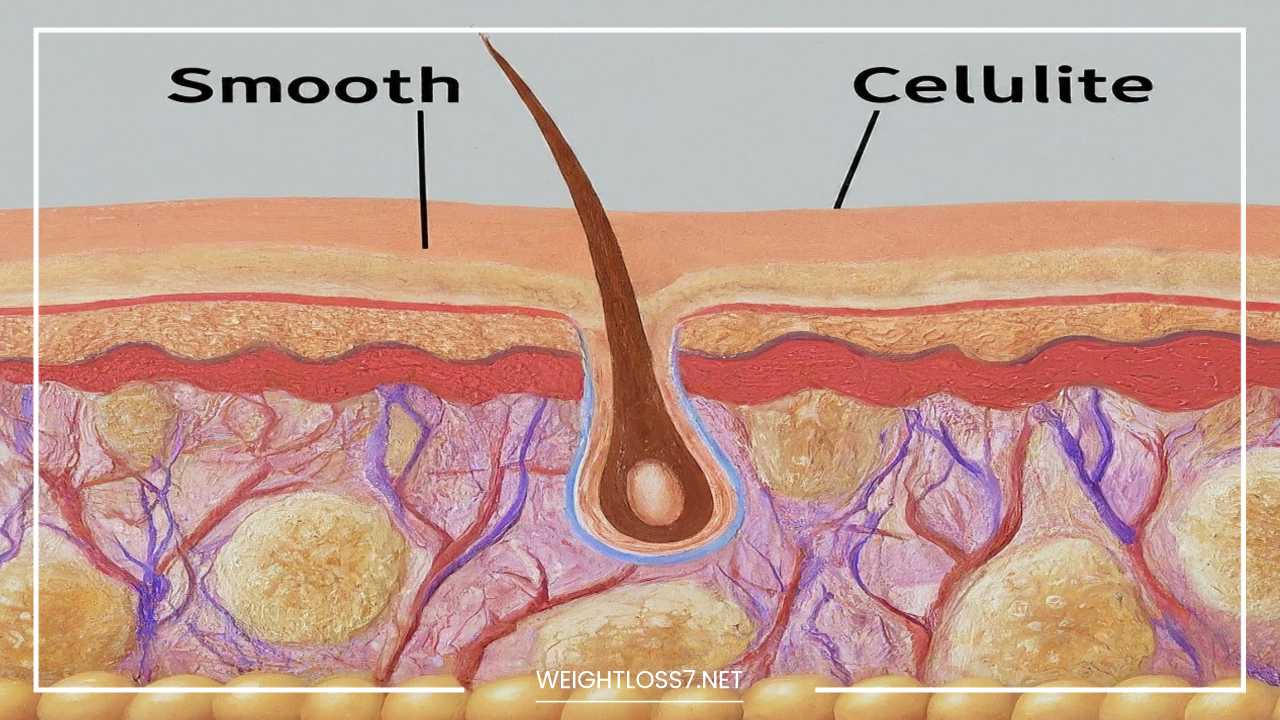How to Get Rid of Cellulite

Get Rid of Cellulite
Living With Less Dimple: A Comprehensive Guide to Cellulite Reduction
Cellulite, those bumpy, uneven patches on the thighs, hips, and buttocks, can be a source of frustration for many. Often referred to as “cottage cheese skin,” its appearance can be a major concern, especially for women.
While it’s a common issue, it’s important to remember it doesn’t signify a health problem.
However, if you’re looking to minimize its visibility and achieve smoother, more toned skin, this comprehensive guide explores various approaches to reach your goals.
Understanding Cellulite: Separating Myth from Science
Before diving into solutions, let’s dispel some common myths. Cellulite isn’t caused by toxins or trapped fat in the way many diet fads or detox programs might suggest. It’s a result of the underlying connective tissue structure beneath the skin.
This connective tissue tethers fat cells, creating a dimpled appearance on the skin’s surface. Genetics, hormones, and even skin thickness play a role in how visible cellulite is.
While weight loss can improve cellulite’s appearance by reducing the overall fat layer, even thin people can have it due to these structural factors.
The Science Behind Cellulite: A Deeper Look
To understand how to address cellulite, it’s helpful to delve a little deeper into the science behind it. Here’s a breakdown of the key players:
-
Connective Tissue: Fibrous septae are bands of connective tissue that run vertically beneath the skin. In areas prone to cellulite, these septae become tighter and pull down on the overlying fat cells, creating a tethered and dimpled appearance.
-
Fat Cells: The size and distribution of fat cells also play a role. In areas with cellulite, fat cells tend to be larger and push against the underlying connective tissue, further contributing to the dimpling effect.
-
Blood Flow and Circulation: Reduced blood flow and lymphatic drainage in cellulite-prone areas can lead to fluid retention and the accumulation of waste products. This can worsen the appearance of cellulite.
-
Hormonal Influences: Hormones, particularly estrogen, can influence the production and distribution of fat cells as well as the structure of connective tissue. This is why fluctuations in hormones, such as those experienced during puberty, pregnancy, and menopause, can affect the visibility of cellulite.
Making Lifestyle Changes for Lasting Results
There’s no magic bullet for cellulite removal, but a combination of healthy habits can significantly improve your skin’s overall tone and texture, making cellulite less noticeable. Here’s how to create a foundation for success:
-
Dietary Strategies for Cellulite Reduction:
- Focus on Whole Foods: Prioritize a balanced diet rich in fruits, vegetables, and whole grains. These foods provide essential nutrients like vitamins, minerals, and antioxidants that promote healthy circulation and cell function, which can indirectly improve the appearance of cellulite.
- Limit Processed Foods: Processed foods are often high in unhealthy fats, sodium, and added sugars. These can contribute to fat storage and inflammation, both of which can worsen cellulite.
- Stay Hydrated: Drinking plenty of water helps flush toxins and keeps your skin plump and hydrated, minimizing the visibility of cellulite. Aim for eight glasses of water daily, adjusting based on your activity level and climate.
-
Exercise is Key: Regular exercise is a powerful tool for reducing cellulite. Here’s a two-pronged approach:
- Cardio for Fat Burning: Cardio activities like brisk walking, swimming, or cycling help burn overall body fat. This can reduce the size and prominence of fat cells, making cellulite less noticeable. Aim for at least 150 minutes of moderate-intensity cardio most weeks.
- Strength Training for Muscle Building: Strength training builds muscle, which improves skin elasticity and smooths the appearance of dimples. Focus on exercises that target your legs, buttocks, and hips, such as squats, lunges, and deadlifts. Aim for strength training exercises that target your major muscle groups at least twice a week.
Self-Care Techniques for a Smoother Appearance
While exercise and diet are crucial for long-term results, some self-care techniques can provide a temporary smoothing effect and improve circulation:
-
Dry Brushing: This technique involves using a natural bristle brush to stimulate circulation and lymphatic drainage. It’s believed to help reduce the appearance of cellulite, although research is limited. Brush your skin in circular motions towards your heart, starting from your feet and working your way up. Ideally, dry brush before showering on dry skin for 5-10 minutes.
-
Self-Massage: Regularly massaging the affected areas with a lotion or oil can improve circulation and temporarily reduce the appearance of cellulite. Use firm, circular motions for 5-10 minutes on areas like your thighs buttocks, and hips. You can also use a handheld massage tool for added pressure.
- Body Wraps: While the long-term effectiveness of body wraps for cellulite reduction is debatable, some people find them helpful for temporary tightening and smoothing. Body wraps typically involve applying a clay, cream, or seaweed mixture to the target area and wrapping it with plastic wrap. The theory is that the wrap helps increase circulation and sweating, potentially leading to a temporary reduction in the appearance of cellulite. However, results are temporary and more research is needed.
Topical Creams and Lotions: Sorting Fact from Fiction
Many creams and lotions claim to reduce cellulite. However, their effectiveness is often limited. Here’s what you need to know:
-
Ingredients to Look For: Some ingredients may offer mild benefits, but don’t expect miracles. Look for creams containing caffeine, retinol, or vitamin A. Caffeine may temporarily improve circulation, while retinol and vitamin A can promote skin cell turnover and improve elasticity.
-
Realistic Expectations: Topical creams can’t permanently change the underlying structure that causes cellulite. They may provide a temporary smoothing effect due to increased hydration or mild tightening, but results are usually subtle and short-lived.
-
Healthy Skepticism is Key: Be wary of products with exaggerated claims or miracle cures. If a product seems too good to be true, it probably is.
Exploring Professional Treatments: Weighing the Options
While not a permanent solution, some in-office treatments can improve the appearance of cellulite, but they come with considerations:
-
Laser Treatments: Several laser therapies target cellulite. They work by heating the underlying tissue, stimulating collagen production, and potentially improving skin texture. Different types of lasers are used, and some may require multiple sessions. Results are temporary, and effectiveness can vary.
-
Radiofrequency (RF) Treatments: Similar to laser treatments, RF uses radio waves to heat the deeper layers of skin. This aims to stimulate collagen production and improve skin elasticity, potentially reducing the appearance of cellulite. Again, multiple sessions may be needed, and results are temporary.
-
Endermologie: This non-invasive treatment uses a motorized device to massage and stimulate the skin. It’s claimed to improve circulation, break down fat deposits, and smooth cellulite. However, research on its effectiveness for cellulite is mixed.
-
Liposuction: This surgical procedure removes fat cells. While liposuction can be effective for overall fat reduction, it’s not specifically recommended for cellulite and may even worsen its appearance. Liposuction comes with risks and side effects, so consulting a board-certified dermatologist or plastic surgeon is crucial.
Important Considerations Before Choosing a Treatment
Consult a board-certified dermatologist or cosmetic surgeon before considering any in-office treatments. They can assess your individual needs, discuss realistic expectations, and recommend the most suitable option based on your goals and medical history.
Be wary of unrealistic claims and remember, these procedures can be expensive and may have side effects. Here are some key questions to ask:
- What are the potential risks and side effects of this treatment?
- How many sessions are typically needed to see results?
- How long do the results typically last?
- What is the cost of the treatment?
Body Positivity: Embracing Your Skin
Cellulite is a normal part of the female body. Studies show that up to 90% of women have some degree of cellulite. While working towards smoother skin is great, it’s important to maintain a healthy body image.
Here are some tips for self-acceptance:
- Focus on What Your Body Can Do: Celebrate your body’s strength, resilience, and all that it allows you to do.
- Surround Yourself with Positivity: Seek out media and messages that promote body positivity and inclusivity.
- Practice Gratitude: Appreciate your body for all that it is, not just how it looks.
Empowering You on Your Cellulite Reduction Journey
This comprehensive guide empowers you to make informed choices about managing cellulite. Remember, you’re not alone!
With a focus on healthy habits, self-care, and realistic expectations, you can achieve smoother-looking skin and a more confident you. Here are some final thoughts:
-
Consistency is Key: Long-term results require consistent effort. Aim for a balanced diet, regular exercise, and self-care practices as part of your routine.
-
Be Patient: It takes time to see results. Don’t get discouraged if you don’t see a dramatic change overnight. Celebrate small victories and stay committed to your goals.
-
Listen to Your Body: Pay attention to how your body feels. If you experience any pain or discomfort during exercise or self-massage, stop and consult a healthcare professional.
-
Embrace a Healthy Lifestyle: Focus on overall health and well-being, not just cellulite reduction. Prioritize good sleep, stress management, and activities you enjoy. When you feel good from the inside out, it shows on the outside.
Final Word: A Holistic Approach to Cellulite Reduction
By taking a holistic approach to cellulite reduction, you can achieve smoother skin and a more positive body image.
Remember, cellulite is a normal part of the female body. Embrace your unique beauty and celebrate all that your body allows you to do!
Remember, there’s no one-size-fits-all solution for cellulite. A combination of healthy habits, self-care techniques, and potentially, professional treatments, can minimize its appearance.
Embrace a holistic approach that prioritizes overall health and well-being. By focusing on healthy practices, self-acceptance, and realistic expectations, you can achieve a more confident and positive relationship with your body.

















